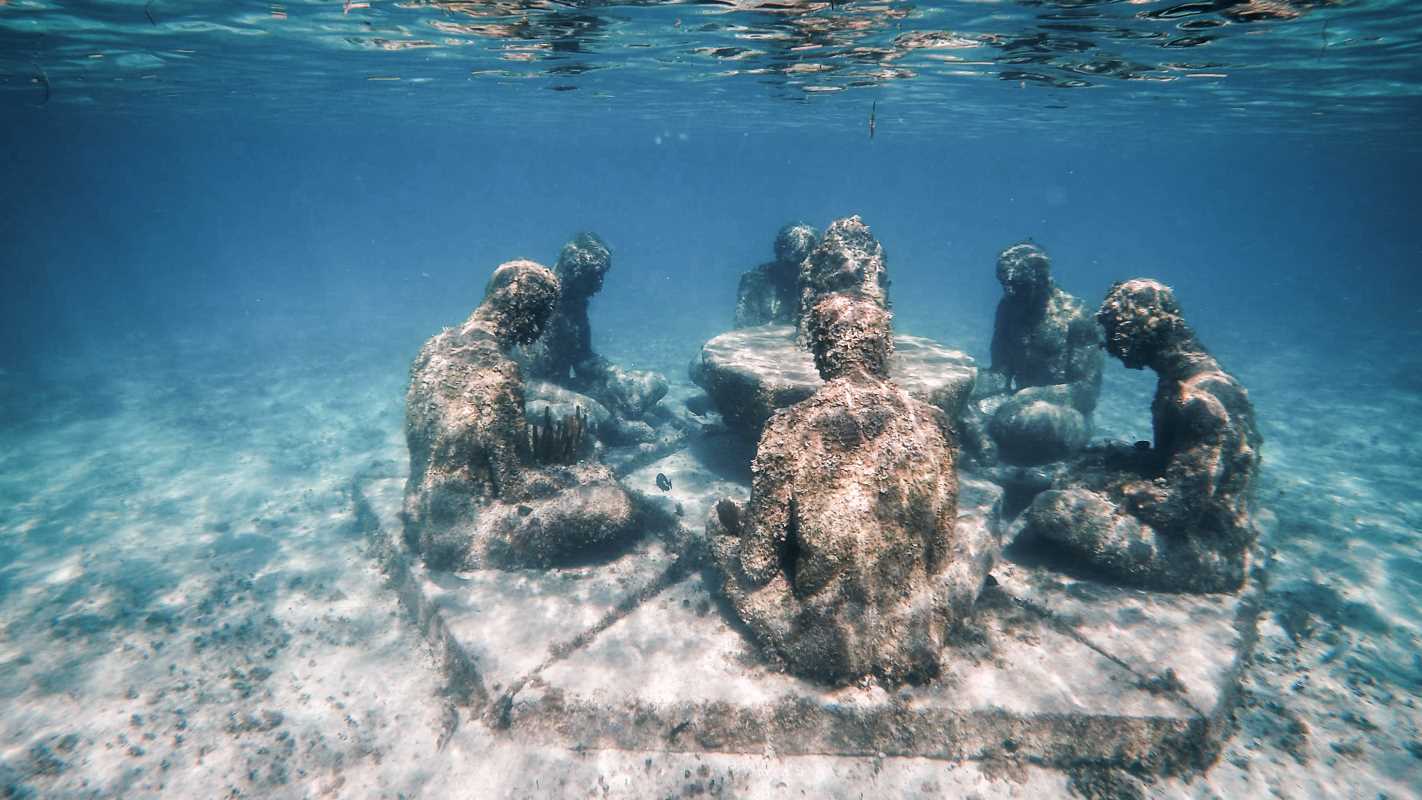Underwater museums and snorkeling art exhibits represent a unique intersection of art, environmental conservation, and adventure tourism. These fascinating installations, submerged beneath the ocean's surface, offer visitors a one-of-a-kind experience, blending creativity with ecological awareness. They are artistic marvels and serve as artificial reefs, fostering marine life and raising awareness about the fragility of underwater ecosystems.
The Concept of Underwater Museums
Underwater museums are collections of sculptures and installations intentionally placed in the sea. Designed to be explored by divers and snorkelers, these submerged galleries provide a surreal experience, combining art's transformative power with the tranquility of the underwater world. The idea emerged as a way to both preserve marine environments and offer an innovative platform for art.
One of the most famous underwater museums is the Museo Subacuático de Arte (MUSA) in Cancun, Mexico. Opened in 2009, MUSA features over 500 sculptures created by artists like Jason deCaires Taylor. The sculptures are crafted from marine-grade cement, designed to promote coral growth. Over time, the pieces evolve as they become colonized by marine organisms, symbolizing the dynamic relationship between human creations and nature.
Snorkeling Art Exhibits: Accessibility for All
While scuba diving offers an immersive way to explore underwater museums, snorkeling art exhibits provide a more accessible option for people of all skill levels. These installations are often placed at shallower depths, making them visible from the surface. This approach broadens participation and allows even casual ocean-goers to enjoy the magic of underwater art.
For example, the Grenada Underwater Sculpture Park in the Caribbean features sculptures like "The Lost Correspondent" and "Vicissitudes," a circle of life-sized figures holding hands. Located at snorkeling-friendly depths, the park invites visitors to float above the works, witnessing how art integrates seamlessly with marine life.
Art as a Catalyst for Marine Conservation
Beyond their artistic appeal, underwater museums serve an essential ecological purpose. The installations act as artificial reefs, providing habitats for marine species and helping restore damaged ecosystems. Coral reefs, often called the "rainforests of the sea," face threats from climate change, pollution, and overfishing. Underwater sculptures provide a stable substrate for corals to grow, supporting diverse marine life.
Underwater art has been incorporated into luxury resorts in locations like the Maldives. British artist Jason deCaires Taylor's Coralarium at the Fairmont Maldives Sirru Fen Fushi exemplifies this. The semi-submerged installation merges contemporary art with reef conservation efforts, creating a sanctuary for marine species while captivating guests.
A Sustainable Tourism Opportunity
Underwater museums and snorkeling art exhibits also promote sustainable tourism. They draw visitors away from natural reefs, reducing human impact on fragile ecosystems. This shift is particularly important in popular diving destinations, where over-tourism can lead to coral bleaching and habitat destruction.
Moreover, these underwater attractions raise awareness about ocean conservation. Artists often create pieces that convey messages about environmental stewardship, climate change, and the interdependence of human and marine life. Visitors leave not only with unforgettable memories but also with a deeper appreciation for the oceans.
Challenges and Considerations
While underwater museums bring numerous benefits, they also face challenges. The installations must be carefully planned to ensure they do not disrupt existing marine ecosystems. Choosing the right materials is critical, as non-toxic, pH-neutral substances are necessary to support coral and marine life growth. The long-term maintenance of these structures requires ongoing investment, as they are exposed to natural forces such as currents and storms.
Another challenge is balancing accessibility with preservation. Increased foot traffic from divers and snorkelers can inadvertently harm the ecosystems these projects aim to protect. Strict regulations and visitor education are vital to mitigate such risks.
A Vision for the Future
As underwater museums and snorkeling art exhibits continue to gain popularity, they represent an inspiring blend of creativity, environmentalism, and adventure. These installations remind us of the beauty and fragility of marine ecosystems, urging individuals and communities to take action to protect them.
The expansion of such projects worldwide offers an opportunity to reimagine how art and conservation can coexist. From Europe’s Museo Atlantico off the coast of Lanzarote to Asia’s growing interest in submerged exhibits, the global appeal of underwater art demonstrates a collective yearning to connect with nature in meaningful ways.
In a world increasingly aware of environmental challenges, underwater museums symbolize hope and innovation. They not only celebrate the human capacity for creativity but also highlight our responsibility to preserve the oceans for future generations. Whether viewed through a snorkel mask or experienced through scuba gear, these submerged galleries offer a profound encounter with the interplay between art and the natural world.







